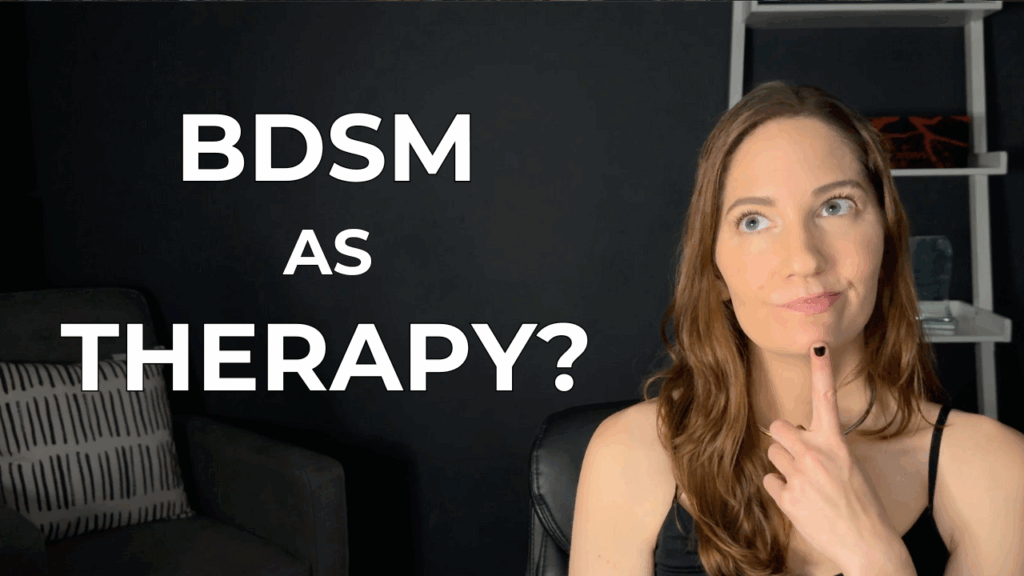
LISTEN TO THE EPISODE:
APPLE PODCASTS | SPOTIFY | IHEART
Most of us are taught that traditional therapy is the ultimate solution for healing our traumas, processing our pain, and finding personal growth. But what happens when therapy just doesn’t quite fit? In my personal experience—and through the stories I hear from readers and clients every day—sometimes the most profound healing happens outside the therapist’s office. Sometimes, it looks a lot more like a scene than a session.
In this post, I’ll share why exploring BDSM has given me something therapy never could. Whether you’ve been left feeling unseen in a therapist’s chair or you just want to know how kink can be a tool for healing, you’ll want to read this before booking your next appointment.
IN THIS EPISODE
- Why traditional therapy isn’t always the best or only path to healing.
- How BDSM can bring deep, embodied healing using touch, breath, and presence.
- Ways BDSM gives you control, agency, and choice that therapy often can’t
- The limitations and biases of modern therapy, especially for women, LGBTQ+ folks, and those practicing kink.
- A personal story on how a single BDSM scene provided emotional release and safety—something years of therapy didn’t.
Does Therapy Really Heal Everyone?
First, let me be crystal clear: I am NOT anti-therapy. I still see a therapist and have used modalities like ketamine therapy and relationship counseling with my Dom. Therapy has quite literally saved lives and helped millions—including myself—navigate grief, trauma, and difficult emotions.
But not all healing journeys look the same. For many of us, therapy can feel disconnected, confusing, or even shame-filled. I remember pouring my heart out after trauma, only to get a worksheet on gratitude or a prescription slip. Instead of compassion, what I got was a sense that maybe the problem was me, or that healing was forever out of reach.
If therapy’s worked for you, that’s great! But if not, you’re not broken. You’re not alone. And you might just need a different path.

The Downsides of Traditional Therapy
What nobody tells you at first is that therapy, for all its benefits, does have limitations. For many people, therapy is a largely cognitive process. You’re encouraged to think about your feelings, analyze your fears, and convince yourself that your reactions aren’t real. This “top-down” approach works for some, but for chronic overthinkers like me, it can feel a bit like gaslighting yourself (and not the fun consensual kind).
Plus, therapy can be inaccessible and even unsafe for many. It’s historically rooted in white, patriarchal, and often sexist or heteronormative ideas. Systemic racism, misogyny, and bias against LGBTQ+ or neurodivergent people still linger in mental health fields. And I know firsthand just how damaging it can be when a therapist pathologizes your kink or identity.
Even if you have insurance, therapy often comes with massive expenses, paperwork, and the sense that you’re just another diagnosis in a system built for profit. It’s not hard to see why so many people fall through the cracks—or never even try seeking help in the first place.
How BDSM Offers What Therapy Can’t
If you’ve ever walked away from therapy feeling more confused or smaller than when you arrived, BDSM might hold the missing piece. No, it isn’t therapy (and shouldn’t replace professional help in a crisis). But it can offer some things that traditional mental health care often can’t.
Healing Lives in the Body, Not Just the Mind
Where therapy is mostly about talking and thinking, BDSM works in the body. Touch, breathwork, impact, sensation, and even rituals are tools that help move trauma through our system on a physical level.
I’ll never forget the first time I was tied up. My breath slowed. My mind stopped spinning. I felt present—held, safe, and grounded. That single experience did more for my nervous system than 20 talk therapy sessions ever had.
When was the last time your physical body felt real safety, comfort, or pleasure during a therapy session?
Choice, Agency, and Reclaiming Power

In most therapy offices, a lot gets dictated for you: timelines, topics, goals. You may feel “observed” or like you’re being labeled by someone with more authority.
Kink is different. In BDSM, you negotiate everything. You choose your role, limits, language, and the rules of engagement. With every scene, you reclaim your voice and agency. For someone like me—a lifelong people-pleaser—learning to express my needs, assert boundaries, and wield consent in every moment has been radically healing. BDSM structures aren’t about losing power; they’re about taking it back.
Rewiring Emotional Patterns Through Experience
Therapy can talk about trust. BDSM lets you practice it. For example, in a scene where my Dom blindfolded me, I panicked unexpectedly. But a safe word, a check-in, and a reassuring touch taught my body it was safe to ask for help and trust someone else. These lived experiences rewire old trauma in a way that simply talking about fears never could.
Is Therapy Safe for Everyone?
Here’s a hard truth: therapy isn’t always safe or inclusive. Modern therapy was rooted in the ideas of men like Freud (who had his own problematic views about sex, gender, and identity). Over time, women have been diagnosed as “hysterical,” Black men overdiagnosed with schizophrenia, and LGBTQ+ folks subjected to conversion therapy. Even today, many neurodivergent people are told they’re broken.
And let’s be honest: not all therapists who claim to be “kink-friendly” or “queer-friendly” actually are. I’ve heard stories from readers and clients about therapists who tolerate rather than accept, or even judge, behind closed doors. That’s why I always recommend discussing a therapist’s real views—ask direct questions before you commit.
For this reason, many people turn to professionals who actually live the lifestyle, like myself, or to community-based healing. You deserve to feel fully seen and affirmed, not just tolerated.
Capitalism, Gatekeeping, and the Cost of Healing

One more thing: The mental health system in places like the United States is deeply tied to capitalism. You need a diagnosis to get care. Sessions often cost hundreds, even with insurance. And in emergencies, people are criminalized instead of helped.
While some folks claim BDSM is all about products and expensive gear, the truth is, genuine healing doesn’t require a $100 flogger. All you really need is trust, consent, and willingness to show up authentically. You can kneel, hold space, or be present for free.
There are no gatekeepers in kink. No premiums. No adjusters. Just the terms you and your partner set—and the power you choose to claim.
My Personal Healing Story With BDSM
Let me share a personal example. After a rough week where I felt numb and disconnected, my Dom asked me before a scene: “How do you want to feel?” Not once in years of therapy had anyone asked me that.
I told him I wanted to feel small, held, and loved. He listened. He tied me up with care, whispered praise, and let me feel everything that came up. I cried—not in sadness, but in relief. My body finally had a safe place to release and be cared for. That was the healing I didn’t even know I needed.
And through exploring scenes like age play, consensual non-consent, and other kinks, I’ve been able to process trauma in ways I could never have accessed through conversation alone.
Can BDSM Replace Therapy?
BDSM isn’t therapy, and that’s the point. If you’re struggling with deep trauma or mental illness, please reach out to a professional. But if you feel unseen, stuck, or dismissed in therapy, know there are other healing paths out there—and BDSM might be one of them.
Kink gave me my body back. My agency. My voice. And if you’re curious to explore, check out my free BDSM healing resources here.
Remember: Your healing is valid. And you deserve a path that truly works for you.
Disclaimer: This article is not medical advice. Every journey is different—please seek professional support if you’re in crisis.
Links From the Episode:

Want more? Sign up for my newsletter and get BDSM tips on the regular.


